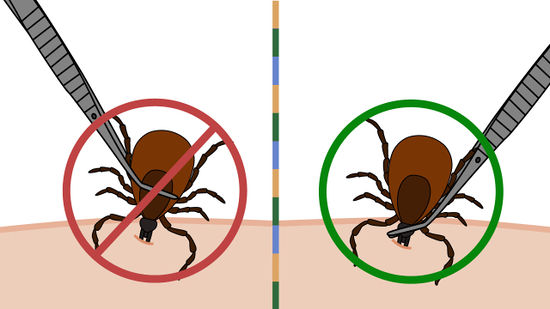Dogs, like humans, are vulnerable to Lyme disease, as well as other tick-borne ailments such as Rocky Mountain spotted fever, so it’s important to perform regular tick checks every time your dog returns from playing near wooded areas.
Ideally, pets should be checked for ticks any time they’ve been outside, especially if they’ve been out hiking or walking in a wooded areas or tall grass. Most often ticks are picked up in rural areas, latching onto pets and people as they walk through brushes or tall grass, but it’s definitely not unheard of for animals to attract ticks in an urban setting as well.
Learning how to remove ticks from your pooch safely can ease pet parents’ anxiety over coming face-to-face with this bloodsucker — so nobody has to miss out on the nice weather!
Step 1: Hold your dog still, part the fur, and take a close look. You want to make sure what you’re looking at is actually a tick! Well meaning dog owners have tried to remove warts, skin tags, cysts, and even nipples thinking they were ticks. Needless to say, this does not go over well with the dog. Ticks are usually a grey or tan-brown colour. Look from the side and see if you can see legs where the tick attaches to your dog’s body.
Step 2: Once you’re sure it’s a tick, use tweezers to grasp the tick as close to your pup’s skin as possible, getting the tweezers between the head of the tick and your dog’s skin. Using steady, firm pressure, pull the tick straight up and away from your dog’s body. Do not squeeze or twist the tick when removing.
Step 3: To make sure you’ve removed all of the tick, take a look at it closely once you’ve pulled it out. If it’s waving it’s legs, it’s alive and you’ve removed the whole thing. If it’s not waving, don’t worry; the remaining head or mouthparts still in your dog won’t make your dog sick, though it may fester a bit more. Your dog’s body will expel the bits left behind naturally.
Step 4: Put the tick in a jar or a Ziploc bag and bring it to your vet for testing for Lyme disease/borrelia. Do not fling it away in disgust, as tempting as that may be. If it’s alive, it could reattach to your dog—or you!
Step 5: Clean the area with some soap and water and apply a bit of Polysporin. It’s normal for it to be a bit pink or red where the tick was attached, or to see a scab and some hair loss.
After all is said and done, the best method for preventing ticks and fleas is through a treatment plan recommended by your vet. Don’t wait until it’s summer time, ticks can come out starting as early as March! Stay safe and prepared 🙂







Leave A Comment
You must be logged in to post a comment.